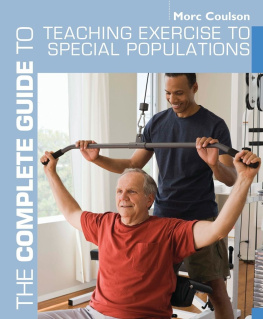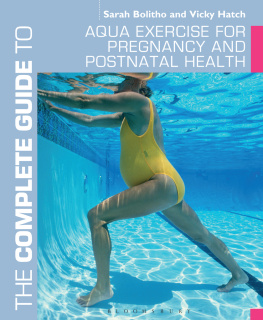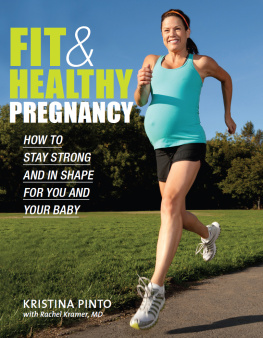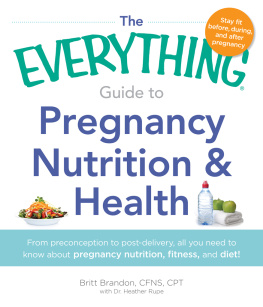The Complete Guide to
Pregnancy and Fitness
Morc Coulson and Sarah Bolitho

Note
While every effort has been made to ensure that the content of this book is as technically accurate and as sound as possible, neither the author nor the publishers can accept responsibility for any injury or loss sustained as a result of the use of this material.
This book has been awarded 2 CPD points by the Register of Exercise Professionals. REPs requires that all instructors regularly update their skills and knowledge, which is evidenced by the recording of 12 CPD points per year. If you already hold an industry qualification you can answer the Try This! sections as part of your professional development. For further information please visit the REPs website at www.exerciseregister.org .
Published by Bloomsbury Publishing Plc
50 Bedford Square
London WC1B 3DP
www.bloomsbury.com
Copyright 2012 Morc Coulson and Sarah Bolitho
ISBN (print): 978 1 4081 5381 9
ISBN (epub): 978 1 4081 7875 1
ISBN (epdf): 978 1 4081 7876 8
This electronic edition published 2012 by Bloomsbury Publishing Plc
All rights reserved
You may not copy, distribute, transmit, reproduce or otherwise make available this publication (or any part of it) in any form, or by any means (including without limitation electronic, digital, optical, mechanical, photocopying, printing, recording or otherwise), without the prior written permission of the publisher. Any person who does any unauthorised act in relation to this publication may be liable to criminal prosecution and civil claims for damages
Morc Coulson and Sarah Bolitho have asserted their rights under the Copyright, Design and Patents Act, 1988, to be identified as the authors of this work.
A CIP catalogue record for this book is available from the British Library.
Acknowledgements
Cover photograph Shutterstock. All inside photographs Grant Pritchard with the exception of the following: part openers one and four Getty Images; part openers two and three Shutterstock
Illustrations by David Gardner
Designed by James Watson
Commissioned by Charlotte Croft
Edited by Sarah Cole
Contents
To my lovely kids, Jackson, Maddison, Ashleigh and Nicholas who just go to show that pregnancy is all worthwhile; and to my lovely wife Lorretta who actually had to go through it! Love you all,
Morc
This is dedicated to my three fantastic children, Lucie, Danny and James, each of whom made the experience of pregnancy worth every symptom and who are now three of the best people I know. This is also for my granddaughter Isla, who enabled me to experience pregnancy from a slight distance while my daughter went through it!
Thanks also goes to all at Crown Fitness, Pontypridd, for allowing us to use their facilities for the photo shoot, as well as to Sam Thomas and Sarah Dowson who are the models in the photographs. Both were 38 weeks pregnant at the time and have now given birth to healthy boys, Elis and Oliver.
Sarah

Part One
Underpinning Knowledge
Chapter 1
Introduction to Pregnancy
KEY POINTS
Instructors wishing to prescribe exercise programmes to women in this population should hold a current Level 2 Fitness Instructor qualification in Gym or Exercise to Music as validated by the Register of Exercise Professionals, as well as a current recognised qualification in ante- and postnatal exercise.
Skills Active is the overseeing body responsible for instructor qualifications in line with the Qualifications and Curriculum Framework (QCF) for health and fitness.
Pregnancy can be split roughly into three time periods, each lasting approximately three months, which are known as trimesters. The first trimester is usually cited as being 013 weeks, the second trimester is 1427 weeks and the third trimester is 2842 weeks.
The period up to 6 weeks after birth is known as the immediate postnatal period and the period from then up to about a year afterwards is referred to as the extended postnatal period.
A normal pregnancy duration is referred to in medical terms as being 40 weeks plus or minus 2 or 3 weeks, however any baby that is born between 37 and 42 weeks is considered to be full term.
Babies have been known to survive delivery as early as only 22 weeks into the pregnancy even though survival rates can be low.
It is possible to estimate the due date or expected delivery date (EDD) as it is also known, if the pregnancy is of the normal duration.
PREGNANCY AND FITNESS
Within the health and fitness environment pregnant women are categorised as a special population as they have particular needs over and above those of the general apparently healthy population. For this reason, those women who are within this population should have a minimum understanding of the condition in order to make informed decisions regarding exercise related to their condition. It is also advisable to seek guidance from a suitably qualified person prior to undertaking any form of exercise programme.
Within the National Qualifications Framework (NQF) for health and fitness, those instructors wishing to prescribe exercise programmes to women in this population should hold a current Level 2 qualification as validated by the Register of Exercise Professionals (REPs) as well as a current recognised qualification in ante- and postnatal exercise. The current Level 2 Award in Fitness Instructing includes limited information for instructors whose participants or clients become pregnant or who occasionally get pregnant women attending their classes. However, while this information gives the instructor enough information to ensure that any class or session is safe for an experienced exerciser who becomes pregnant, it is not sufficient to work with this client group on a regular basis or to work with previously inactive women who are pregnant.
It is not the purpose of this book to discuss reproduction or the progression of pregnancy in clinical detail, but to consider the implications that pregnancy has for exercise and activity. If the reader requires further information on these aspects of pregnancy there are numerous books available that cover the topic in great detail.
Pregnancy can be split roughly into three-month time periods, which are better known as trimesters as seen in . Once the mother has given birth there are two further time periods known as the immediate postnatal period and the extended postnatal period.
For more information relating to qualifications within the industry please refer to www.skillsactive.com and for information relating to the professional qualifications register please refer to www.exerciseregister.org . The content of this book is aligned to Level 3 National Occupational Standards for Ante- and Postnatal Exercise and is an ideal accompaniment to the courses available from leading training providers.
The three-trimester period prior to birth is referred to as the antenatal period, whereas when a woman has given birth, the period up to about a year afterwards is known as the postnatal period. A normal pregnancy (one which is considered to be of a standard duration) is referred to in medical terms as being 40 weeks plus or minus 2 or 3 weeks. In other words, a normal pregnancy lasts for a duration of between 38 and 42 weeks. It is possible to estimate the due date or expected delivery date (EDD), as it is otherwise known, if the pregnancy is of the normal duration. The following steps show an example of how to estimate the EDD.










